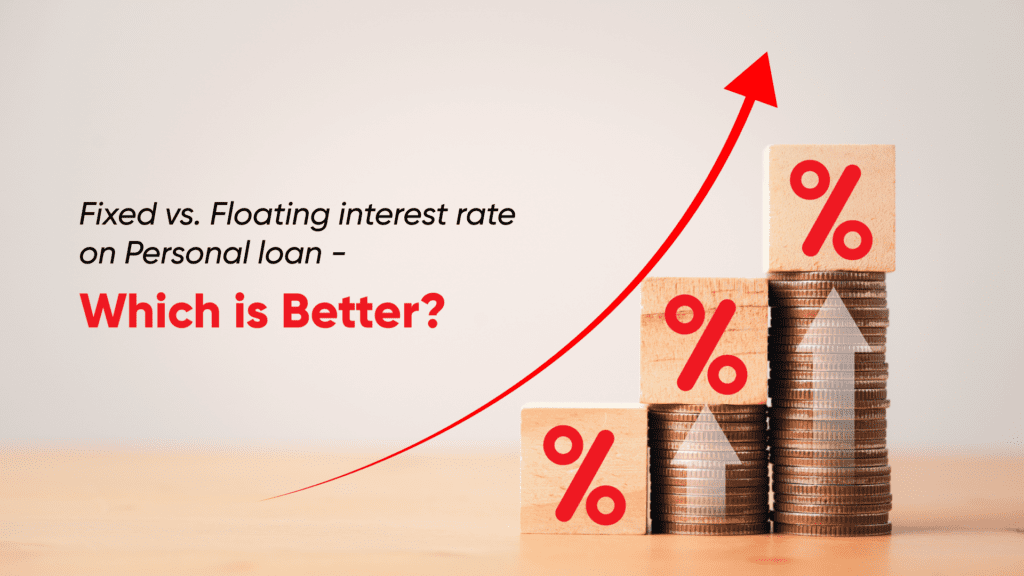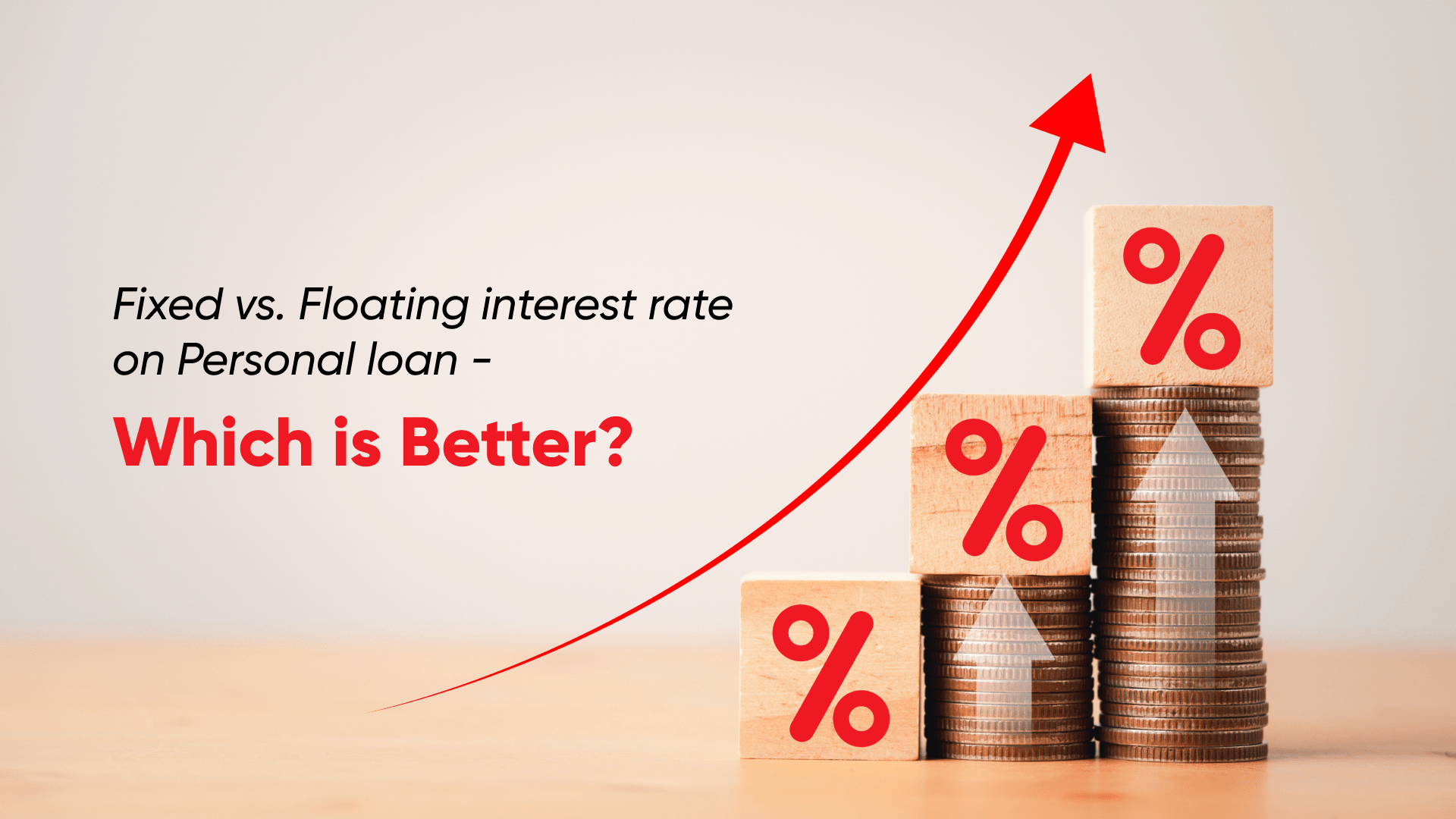Fixed vs. Floating Interest Rate on Personal loan - Which is Better?

When considering a personal loan, one of the critical decisions is choosing between a fixed interest rate and a floating interest rate. Understanding fixed vs floating interest rate is crucial for borrowers to make an informed borrowing decision. A fixed interest rate remains constant throughout the loan tenure, offering predictability and stability in repayments. What is floating interest rate? A floating interest rate fluctuates based on market dynamics, which can mean lower interest rates during certain periods but also the potential for higher rates at other times.
The choice between fixed or floating interest rate hinges on various factors, including market conditions, loan duration, and individual financial stability. Borrowers must weigh the pros and cons of each option, considering how floating interest rate vs fixed interest rate can impact their financial planning.
Table of Contents
ToggleFixed or floating interest rates, which one should you choose?
Deciding between fixed and floating interest rate is a significant choice for borrowers considering a personal loan. A fixed interest rate provides the stability of constant EMIs throughout the loan tenure, making financial planning more predictable. This stability is particularly beneficial for short-term loans, where the total repayment amount remains unchanged. However, fixed rates are often 1 to 2% higher than flexible rates, which can be a drawback for long-term loans.
On the other hand, a floating interest rate adjusts periodically, aligning with changes set by the RBI. This means that the total repayment amount and loan tenure on the personal loans can vary. Borrowers might prefer a floating interest rate if they anticipate a downward trend in repo rates or expect an increase in income, allowing them to save on total repayment costs and pre-payment fees.
Key Advantages of Floating Interest Rate
Floating interest rates, also known as variable rates, adjust periodically in line with market conditions or benchmark rates. They often start with lower introductory rates, which makes them appealing for short-term borrowing or plan to repay the loan quickly. These rates can decrease, potentially lowering monthly payments. Floating rates are commonly used in adjustable-rate mortgages (ARMs) and credit cards, offering flexibility but also unpredictability in long-term financial planning.
Another key advantage of a floating interest rate is its dynamic nature. Although there’s a possibility that the floating interest rate might occasionally rise above the fixed interest rate, it is also likely to decrease over time due to market fluctuations. This volatility can lead to considerable savings over the loan tenure.
Drawbacks of Floating Interest Rate
While a floating interest rate can offer advantages like lower costs, it’s important to understand its drawbacks. The primary challenge with a floating interest rate is the uncertainty and fluctuation it brings to monthly repayments. This variability can introduce a degree of financial instability, making it challenging for borrowers to plan their monthly budgets effectively.
Another significant concern with a floating interest rate is the potential for the rate to remain high over an extended period. If the floating interest rate on a loan, such as a home loan, stays above a certain threshold – for instance, 11.5% per annum – for a prolonged duration, the anticipated savings compared to a fixed interest rate may not materialize.
Also Read: What is a Loan Repayment Schedule and Why is it Important?
What is the Fixed Rate of Interest?
A fixed interest rate is a type of interest rate on a loan where the rate remains constant throughout the loan tenure. This consistency contrasts with a floating interest rate, which can fluctuate in response to market conditions. The stability of a fixed interest rate means that borrowers have the certainty of knowing exactly what their loan repayments will be over time, making financial planning more straightforward.
This is particularly advantageous for those who prefer to have a consistent repayment schedule without the uncertainty associated with the changing market rates that affect a floating interest rate. However, it’s important to note that typically, a fixed interest rate may be set higher than a floating interest rate. This higher rate is the trade-off for the stability it provides.
Key Advantages of Fixed Interest Rate
One of the most significant benefits is the predictability it provides. With a fixed interest rate, borrowers have the certainty of knowing their exact repayment amount throughout the loan tenure. This predictability facilitates easier budgeting and financial planning, as the EMI (Equated Monthly Installment) remains constant, regardless of market fluctuations.
Another advantage of a fixed interest rate is the sense of security it offers. Unlike a floating interest rate, which can vary and sometimes increase significantly, a fixed interest rate shields borrowers from the risk of rising interest rates. This stability is especially beneficial in a rising interest rate environment.
Drawbacks of Fixed Interest Rate
While a fixed interest rate offers stability and predictability, it also comes with certain drawbacks. One of the main disadvantages is the higher cost. Typically, a fixed interest rate is set 1.5% to 2% higher than a floating interest rate. This higher rate can significantly increase the overall cost of a loan, making it a more expensive option in the long run.
Another drawback is the lack of flexibility to benefit from market rate decreases. In a fixed interest rate scenario, if the market rates fall, borrowers with a fixed rate will not benefit from these lower rates. This is in contrast to a floating interest rate, where borrowers can potentially enjoy reduced interest rates when market rates decline.
Fixed vs. Floating Interest Rates: Key Differences to Help you Make an Informed Decision
When deliberating between fixed and floating interest rate, it’s crucial to tailor the comparison to your specific financial situation and goals.
Risk Tolerance and Market Predictions: If you have a low risk tolerance and prefer predictable financial planning, a fixed interest rate is more suitable. It offers the security of knowing your exact repayment amount throughout the loan period. However, if you’re adept at predicting market trends and are comfortable with some level of risk, a floating interest rate might be more advantageous, especially in a declining interest rate environment.
Loan Tenure Considerations: For shorter loan tenures, a fixed interest rate often makes more sense due to its stability and less overall interest cost. In contrast, for longer loan tenures, a floating interest rate could be beneficial as it usually starts lower than fixed rates and can potentially decrease further over time.
Financial Flexibility: A floating interest rate can be preferable if you anticipate an increase in income or plan to prepay your loan. This flexibility allows you to capitalize on lower rates when they occur. On the other hand, if you prefer a fixed budget without surprises, the fixed interest rate is the way to go.
Conclusion:
In conclusion, the decision between fixed and floating interest rate depends on individual financial circumstances and market conditions. A fixed interest rate offers stability and predictability, ideal for those who prefer consistent repayments and a risk-averse approach.
On the other hand, a floating interest rate can be advantageous in a declining rate environment, offering potential savings for those comfortable with variability and market trends. Ultimately, when considering fixed vs floating interest rate, it’s about balancing personal financial goals, risk tolerance, and market predictions to make the most informed and beneficial choice for your financial future.
Frequently Asked Question
It depends on individual preferences: choose a fixed interest rate for stability and predictability or a floating interest rate for potential savings in a declining rate environment.
To secure a low personal loan interest rate, maintain a strong credit score, compare multiple lenders, and negotiate loan terms effectively.
Using both floating and fixed interest rates provides a balance, offering stability from fixed rates and potential savings from floating rates.
Opt for a floating interest rate if you’re comfortable with risk and can potentially benefit from future decreases in market rates.
Advantages include market responsiveness and economic flexibility; disadvantages involve increased volatility and unpredictability.
To avoid high interest rates on loans, maintain a good credit score, opt for shorter loan terms, and compare various lender offers.
Higher interest rates generally benefit lenders and investors, as they earn more on loans and investment products.
The floating interest rate rule adjusts the loan’s interest rate based on market conditions and benchmark interest rates.













